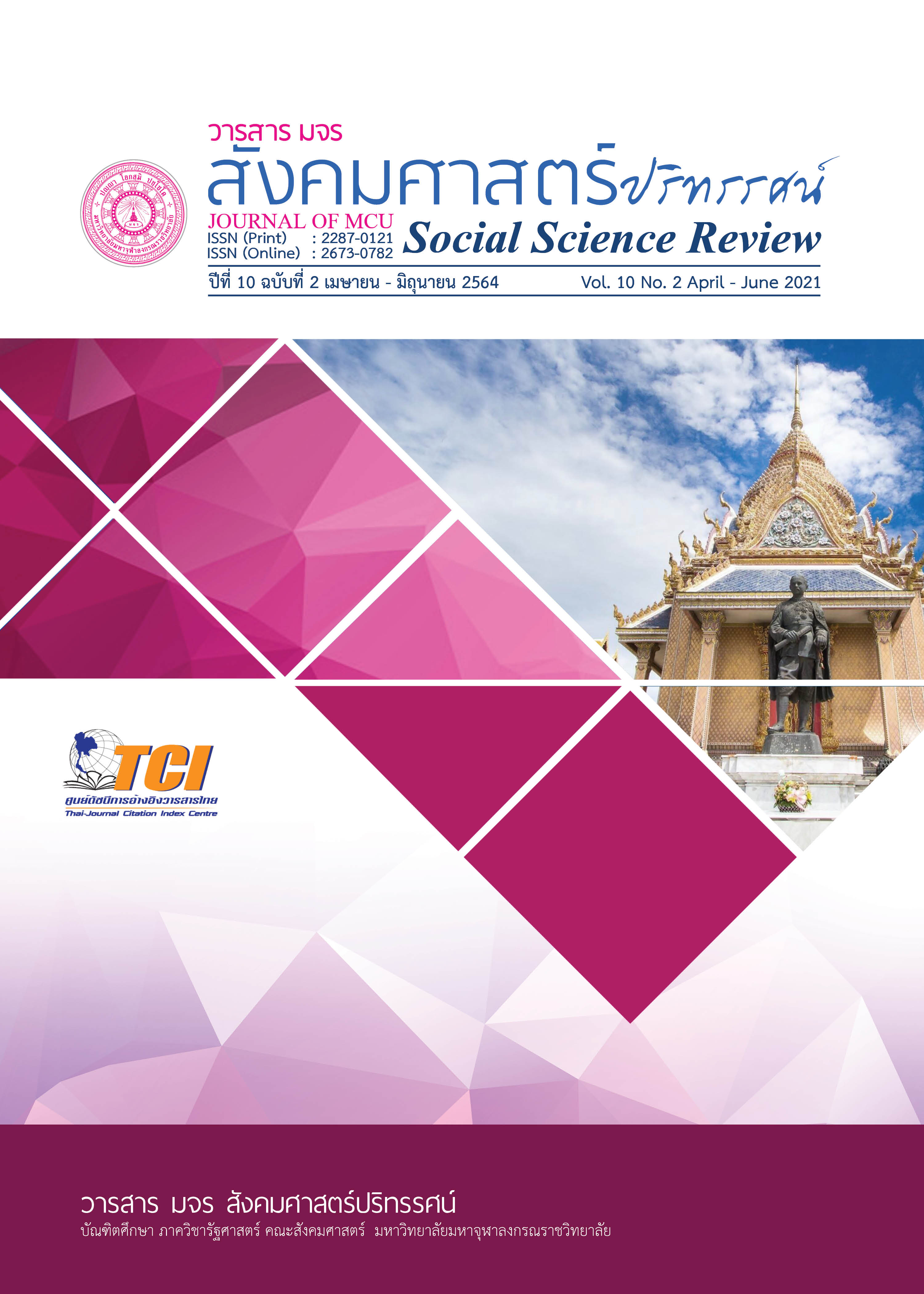การประยุกต์หลักสาราณียธรรมเพื่อส่งเสริมความผูกพันต่อองค์กรของบุคลากรเทศบาลในจังหวัดนครราชสีมา
คำสำคัญ:
สาราณียธรรม, ความผูกพันต่อองค์กร, เทศบาลบทคัดย่อ
บทความวิจัยนี้มีวัตถุประสงค์เพื่อศึกษาความผูกพัน ปัจจัยที่ส่งต่อความผูกพันและนำเสนอรูปแบบการประยุกต์หลักสาราณียธรรมเพื่อส่งเสริมความผูกพันต่อองค์กรของบุคลากร ดำเนินการตามระเบียบวิธีวิจัยแบบผสานวิธี โดยการวิจัยเชิงปริมาณใช้แบบสอบถามที่มีค่าความเชื่อมั่นทั้งฉบับเท่ากับ 0.973 เก็บข้อมูลจากกลุ่มตัวอย่าง คือ บุคลากรเทศบาลในจังหวัดนครราชสีมา จำนวน 470 คน วิเคราะห์ข้อมูลโดยหาค่าความถี่ ค่าร้อยละ ค่าเฉลี่ย ส่วนเบี่ยงเบนมาตรฐานและการวิเคราะห์โมเดลสมการโครงสร้าง (SEM) โดยใช้การวิเคราะห์องค์ประกอบเชิงยืนยัน (CFA) การวิจัยเชิงคุณภาพใช้วิธีการสัมภาษณ์เชิงลึกกับผู้ให้ข้อมูลสำคัญ จำนวน 17 รูปหรือคนแบบตัวต่อตัว วิเคราะห์ข้อมูลโดยการวิเคราะห์เนื้อหาเชิงพรรณนาและการสนทนากลุ่มเฉพาะจำนวน 9 รูปหรือคน เพื่อยืนยันโมเดลหลังจากการสังเคราะห์ข้อมูล
ผลการวิจัยพบว่า 1. ความผูกพันต่อองค์กรโดยภาพรวม อยู่ในระดับมาก 2. ปัจจัยที่ส่งต่อความผูกพันต่อองค์กร พบว่า การสร้างความผูกพันต่อองค์กรและแรงจูงใจในการปฏิบัติงานผ่านหลักสาราณียธรรม 6 ส่งผลต่อความผูกพันต่อองค์กรของบุคลากรโดยรวมได้ร้อยละ 68 และ 3. รูปแบบการประยุกต์หลักสาราณียธรรมเพื่อส่งเสริมความผูกพันต่อองค์กร พบว่า ความผูกพันต่อองค์กรของบุคลากรมีปัจจัยพื้นฐาน 2 อย่าง คือ แรงจูงใจในการปฏิบัติงานและการสร้างความผูกพันต่อองค์กร โดยประยุกต์หลักสาราณียธรรม 6 มาใช้เพื่อเป็นตัวส่งเสริมให้เกิดความผูกพันต่อองค์ของบุคลากรมากยิ่งขึ้น
เอกสารอ้างอิง
คณะกรรมการและอนุกรรมการจังหวัด. (2560). แผนพัฒนาจังหวัดนครราชสีมา 4 ปี (พ.ศ. 2461 -2564) ทบทวนปี พ.ศ. 2560. นครราชสีมา: องค์การบริหารส่วนจังหวัดนครราชสีมา.
เจตน์ ตันติวณิชชานนท์. (2557). บทบาทของพระพุทธศาสนาในการพัฒนาชาติ : มุมมองของอาจารย์ ป๋วยอึ๊ง ภากรณ์. วารสารสันติศึกษาปริทรรศน์ มหาวิทยาลัยมหาจุฬาลงกรณราชวิทยาลัย, 4(2), 341-355.
ณรัฐ สวาสดิ์รัตน์. (2558). รูปแบบการพัฒนาศักยภาพการปฏิบัติงานของอาสาสมัครทหารพรานในจังหวัดชายแดนภาคใต้ตามหลักพุทธธรรม (วิทยานิพนธ์พุทธศาสตรดุษฎีบัณฑิต สาขาวิชารัฐประศาสนศาสตร์). พระนครศรีอยุธยา: มหาจุฬาลงกรณราชวิทยาลัย.
ตุลา มหาสุธานนท์. (2545). หลักการจัดการ หลักการบริหาร. กรุงเทพฯ: ธนธัชการพิมพ์.
ผดุง วรรณทองและคณะ. (2561). การประยุกต์ใช้หลักอิทธิบาท 4 ในการบริหารองค์กรเอกชนในจังหวัดนนทบุรี. วารสาร มจร สังคมศาสตร์ปริทรรศน์, 7(2),112-124.
พรชนก ทองลาด. (2550). อิทธิพลของพรหมวิหารธรรมที่มีต่อความพึงพอใจในการทำงานและการปฏิบัติงานของพนักงานโรงงานเซรามิคในภาคเหนือตอนบน (วิทยานิพนธ์ปรัชญาดุษฎีบัณฑิต สาขารัฐประศาสนศาสตร์). กรุงเทพฯ: มหาวิทยาลัยรามคำแหง.
พระพรหมคุณาภรณ์ (ป.อ. ปยุตฺโต). (2559). พจนานุกรมพุทธศาสตร์ ฉบับประมวลธรรม (พิมพ์ครั้งที่ 34), กรุงเทพฯ: มหาวิทยาลัยมหาจุฬาลงกรณราชวิทยาลัย.
พระปลัดเทียน พลวุฑฺโฒ (คำพงษ์). (2557). การส่งเสริมจริยธรรมขององค์กรปกครองส่วนท้องถิ่นในภาคเหนือตอนบน (วิทยานิพนธ์ปริญญาพุทธศาสตรดุษฎีบัณฑิต สาขาวิชารัฐประศาสนศาสตร์). พระนครศรีอยุธยา: มหาวิทยาลัยมหาจุฬาลงกรณราชวิทยาลัย.
แม่ชีวงเพชร คงจันทร์. (2556) การศึกษาวิเคราะห์ความสัมพันธ์ระหว่างหลักพุทธธรรมกับหลักกฎหมาย : กรณีศึกษาพระราชบัญญัติคุ้มครองผู้ถูกกระทำด้วยความรุนแรงในครอบครัว (วิทยานิพนธ์ปริญญาพุทธศาสตรดุษฎีบัณฑิต สาขาวิชาพระพุทธศาสนา). พระนครศรีอยุธยา: มหาวิทยาลัยมหาจุฬาลงกรณราชวิทยาลัย.
วิลาวรรณ รพีพิศาล. (2549). การบริหารทรัพยากรมนุษย์. กรุงเทพฯ: สำนักพิมพ์วิจิตรหัตกร.
สำนักงานส่งเสริมการปกครองส่วนท้องถิ่น จังหวัดนครราชสีมา. การบริหารจัดการทรัพยากรบุคคลของสำนักงานส่งเสริมการปกครองส่วนท้องถิ่น จังหวัดนครราชสีมา. สืบค้น 8 กุมภาพันธ์ 2564, จาก http://www.koratdla.go.th
ดาวน์โหลด
เผยแพร่แล้ว
รูปแบบการอ้างอิง
ฉบับ
ประเภทบทความ
สัญญาอนุญาต
ลิขสิทธิ์ (c) 2021 วารสาร มจร สังคมศาสตร์ปริทรรศน์

อนุญาตภายใต้เงื่อนไข Creative Commons Attribution-NonCommercial-NoDerivatives 4.0 International License.
เพื่อให้เป็นไปตามกฎหมายลิขสิทธิ์ ผู้นิพนธ์ทุกท่านต้องลงลายมือชื่อในแบบฟอร์มใบมอบลิขสิทธิ์บทความให้แก่วารสารฯ พร้อมกับบทความต้นฉบับที่ได้แก้ไขครั้งสุดท้าย นอกจากนี้ ผู้นิพนธ์ทุกท่านต้องยืนยันว่าบทความต้นฉบับที่ส่งมาตีพิมพ์นั้น ได้ส่งมาตีพิมพ์เฉพาะในวารสาร มจร สังคมศาสตร์ปริทรรศน์ เพียงแห่งเดียวเท่านั้น หากมีการใช้ภาพหรือตารางหรือเนื้อหาอื่นๆ ของผู้นิพนธ์อื่นที่ปรากฏในสิ่งตีพิมพ์อื่นมาแล้ว ผู้นิพนธ์ต้องขออนุญาตเจ้าของลิขสิทธิ์ก่อน พร้อมทั้งแสดงหนังสือที่ได้รับการยินยอมต่อบรรณาธิการ ก่อนที่บทความจะได้รับการตีพิมพ์ หากไม่เป็นไปตามข้อกำหนดเบื้องต้น ทางวารสารจะถอดบทความของท่านออกโดยไม่มีข้อยกเว้นใดๆ ทั้งสิ้น





